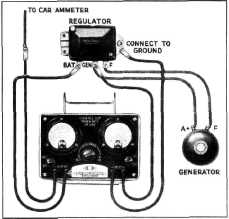1942 - 1947 CHEVROLET SHOP MANUAL
Section 12 - Electrical System
|
|
|||
|
12-11
|
|||
|
|
|||
|
the field lead on the
field terminal of the regulator.
(b)
Remove the regulator cover and depress the voltage regulator
armature manually to open the points. If the output now drops off, the
voltage regulator unit has been failing to reduce the output as the
battery came up to charge and
voltage regulator adjustment is indicated.
(Instructions for
adjusting the regulator are covered under the heading "Voltage
Regulator Adjustment.")
(c)
If separating the voltage regulator contacts does not cause
the output to drop off, the field circuit within the regulator is
shorted and the regulator should be replaced.
3. WITH A LOW BATTERY AND A LOW
OR NO CHARGING RATE check the circuit
for loose connections, corroded
battery ter≠minals, loose or corroded ground strap, and
frayed or damaged wires. The high
resistance resulting from
these conditions will prevent nor≠mal
charge from reaching the battery. If the
entire charging circuit is in good
condition, then either the
regulator or generator is at fault.
(a)
With a jumper wire ground the field ter≠minal of the regulator
to the engine block or other good ground. Increase the gen≠erator
speed to determine which unit needs attention. Use care to avoid
excessive speed since under these conditions the generator may produce
a dangerously high output.
(b)
If the output does not increase, the regu≠lator needs
attention. Check for dirty or oxidized contact points or a low voltage
setting.
(c)
If the generator output
remains at a few amperes with the field terminal grounded, the
generator is at fault and should be checked further.
(d)
If the generator does not show any output at all. either with
or without the field ter≠minal grounded, very quickly disconnect the
generator lead from the generator (GEN) terminal of the regulator and
strike it against a convenient ground with the generator operating at
a medium speed. If a spark does not occur, the trouble has now been
definitely isolated in the gen≠erator and it should be removed and
re≠paired.
If a spark does occur,
likely the generator can build up but the circuit breaker is not
operating to permit the current to flow to the battery due to burnt
points, points not
|
closing, open voltage
winding, grounded circuit breaker, or too high voltage setting.
NOTEóDo not operate
the generator with the generator lead disconnected for any length of
time since this is open circuit operation and the units will be
damaged* A burned regulator re≠sistance unit, regulator winding, or
fused con≠tacts can result only from an open circuit oper≠ation or
extreme resistance in the charging circuit. With these conditions
check wiring be≠fore reinstalling regulator.
DO NOT RUN OR TEST
GENERATOR ON OPEN CIRCUIT. TO DO SO MAY DESTROY REGULA≠TOR OR
GENERATOR.
CHECKS AND ADJUSTMENTS
When checking and
adjusting current and volt≠age regulator units, it is essential that
reliable in≠struments be used. A volt ammeter with 1/4 ohm
|
||
 |
|||
|
Fig. 21-Volt Ammeter Connections for Checking
Circuit Breaker
variable resistance in
series with the ammeter is required for checking and adjusting voltage
regu≠lators.
CIRCUIT BREAKER (Cut-Out Relay)
Disconnect the battery
wire from the battery (BAT) terminal of the regulator. Connect the
posi≠tive lead of the ammeter to the battery terminal of the regulator
and the negative lead to the bat≠tery wire. Connect the positive lead
of the volt≠meter to the generator terminal of the regulator and the
negative lead to ground, Fig. 21. Gradually increase the engine speed,
noting the voltage at which the circuit breaker points close. This
should
|
|||
|
|
|||